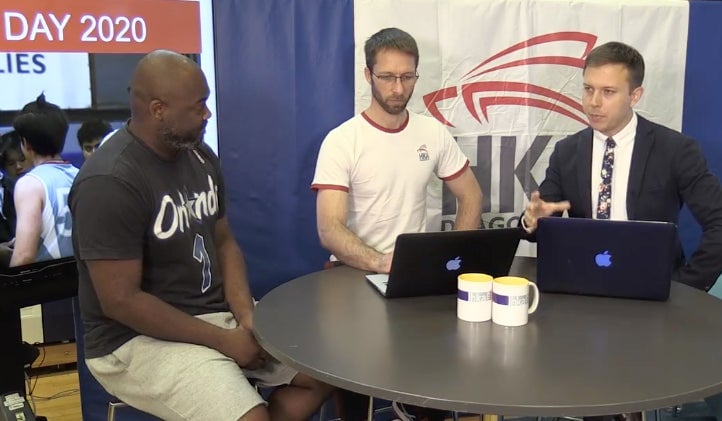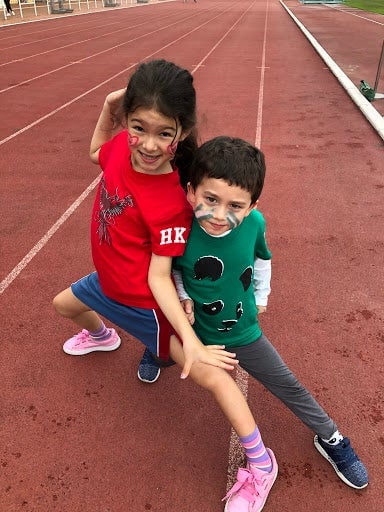Coronavirus didn’t stop this Hong Kong school from hosting a virtual sports day
The livestream starts with the familiar blare of dramatic music and a burst of colors on screen, similar to the opening frames on ESPN or SkySports. Behind a desk sit two men, one a sports coach in a suit, the other a teacher dressed in athletic attire. Both are positioned behind computers and monitoring a leaderboard with incoming individual scores and house points (stay with me).


The livestream starts with the familiar blare of dramatic music and a burst of colors on screen, similar to the opening frames on ESPN or SkySports. Behind a desk sit two men, one a sports coach in a suit, the other a teacher dressed in athletic attire. Both are positioned behind computers and monitoring a leaderboard with incoming individual scores and house points (stay with me).
This is not live television, but a two-hour livestream of a virtual sports day at Hong Kong Academy, an independent day school in Hong Kong for 600 children aged 3-18. The commentators are the school’s athletics director, Simon Roberts, in a suit (cue the joke: “You all are not used to seeing me dressed like this”) and Jan Boshoff, HKA’s technology manager, donning an athletic top and tracksuit bottoms, with guests joining throughout the show (pictured above on left: Anton Buntin, learning specialist and basketball coach).
The presenters employ high-energy, sports-commentator-like voices (“FANTASTIC TO SEE SO MANY OF YOU ONLINE” starts Roberts) and give the students an eight-part challenge including push-ups, distance running, and a plank test.
HKA students have been home since Feb. 25, when Hong Kong ordered schools closed in response to the Covid-19 outbreak. The move, which followed the long Chinese New Year holiday, forced the school’s teachers and administrators to get creative about ensuring not only academic learning takes place, but also activities such as physical education, art, drama, and music.
They are not alone. With 290 million students out of school worldwide due to Covid-19, parents, students, and teachers are having to embrace online learning, regardless of whether they think it’s effective or know, exactly, how best to use it.
In China, where students are into their fifth week of online learning, a chief concern of administrators and teachers is student well-being. HKA regularly surveys students, and many have shared that it’s stressful to spend so much time online. Virtual sports day is an effort to change things up.
“It’s to try and keep fun in learning,” said Steve Dare, head of the school.
The idea came from teachers and administrators thinking of ways to battle school-cancelation fatigue. “We want to look for any chance to make sure kids aren’t missing out,” Dare said. The idea started as a spreadsheet, and soon athletics was talking to tech staff, who had experience live-streaming events (graduation is live-streamed as it is an international school and many relatives cannot attend in person).
Dare said participation was high, though the results are still coming in: the livestream happened Thursday March 5, but students could post results through Sunday evening. “A lot of this is based on trust,” he said. “When you can’t see them, there is a positive presupposition that they will treat this seriously.”

A live map showed students logging in from the US and Canada, with most coming from Hong Kong. Kids submitted video results and times as they completed the challenges; some did them at home, some at nearby outdoor areas. The brother and sister below went to a local track in Hong Kong.

The scores were tallied by individual and by “house,” or the teams that kids are divided into to foster group competition.
Roberts and Boshoff kept up a stream of live commentary with a variety of content. A set of spandex-clad teachers started with a “stretch off,” demonstrating how to limber up; Roberts and Boshoff each demonstrated a “stork leg” balance challenge, timing themselves twice each (the technology manager crushed the athletics director, ICYWW). They discussed how to develop certain skills and why they are important and whether gender assumptions about strength and coordination are accurate.
One does not need a reminder that the livestream is hosted by a school. It starts with a typical health and safety warning (Hong Kong style): If you live near a cliff, don’t do the ball challenge next to it; wear appropriate clothing. Teachers often look into the wrong camera, audio quality varies, and the transitions are rough. But this is part of the joy: The teachers model to the students what it means to take a risk on something new. For once, they too are amateurs.